Gyps bochenskii sp. n. (Aves: Falconiformes) from the Late ... - ecodb
Gyps bochenskii sp. n. (Aves: Falconiformes) from the Late ... - ecodb
Gyps bochenskii sp. n. (Aves: Falconiformes) from the Late ... - ecodb
You also want an ePaper? Increase the reach of your titles
YUMPU automatically turns print PDFs into web optimized ePapers that Google loves.
Boev Z.<br />
chus (MLÍKOVSKÝ 2000). Vultur fossilis s. MORENO<br />
& MERCERAT, 1891 is a synonym of recent Vultur<br />
gryphus (LINNAEUS), 1758), i. e. it is a ciconiid, but<br />
not accipitrid vulture.<br />
As can be seen, only 3 fossil <strong>sp</strong>ecies of vultures<br />
(Palaeohierax gervaisii, <strong>Gyps</strong> melitensis, Gypaetus<br />
osseticus) are known <strong>from</strong> Neogene and Quaternary of<br />
Europe. Here we remind <strong>the</strong> possible identity of P. gervaisii<br />
and G. angolensis (OLSON 1985). As MLÍKOVSKÝ<br />
(2002) writes, <strong>the</strong> distinct status of G. melitensis is<br />
dubious and it only remains to be shown, whe<strong>the</strong>r it<br />
is different <strong>from</strong> <strong>the</strong> modern vulture <strong>sp</strong>ecies. He lists<br />
no o<strong>the</strong>r Old World vulture taxa except P. gervaisii<br />
(<strong>Late</strong> Oligocene, MP 25 and Early Miocene, MN 2a),<br />
A. monachus (since <strong>Late</strong> Pleistocene, MQ 2C), and<br />
<strong>the</strong> Bulgarian record of <strong>Gyps</strong> <strong>sp</strong>. (<strong>Late</strong> Pliocene, MN<br />
17, subject of <strong>the</strong> present paper).<br />
Description of <strong>the</strong> site<br />
General data: <strong>Late</strong> Pliocene (Villanyian, MN 17<br />
zone) vertebrate fauna of <strong>the</strong> site near <strong>the</strong> town of<br />
Varshets (North-Western Bulgaria) is relatively well<br />
studied (POPOV 2001, SPASSOV 1997 a, b). The site<br />
represents a ponor, which provided a large number<br />
of avian fossils. Varshets is <strong>the</strong> richest paleornithological<br />
site in Bulgaria (BOEV 2002). At <strong>the</strong> present<br />
time <strong>the</strong> list consists in 123 <strong>sp</strong>ecies of birds and<br />
mammal. This high paleofaunal diversity makes it<br />
<strong>the</strong> richest Tertiary site with a Villanyian (as well<br />
as of Villafranchian) age in Europe. Its exploration<br />
started in 1988 and about 1750 bird fossils have been<br />
collected so far (BOEV 1999; 2002; unpubl. data).<br />
The site is <strong>the</strong> type locality of a new genus and a<br />
new <strong>sp</strong>ecies (Chauvireria balcanica BOEV, 1997) of<br />
Perdicinae as well as a series of o<strong>the</strong>r taxa (BOEV<br />
2002, 2007). The paleoenvironment has been determined<br />
as a xerophytic forest-steppe (BOEV 1995,<br />
1999).<br />
Taphonomy: The accumulation of avian remains<br />
may be explained as a feeding location of<br />
large owls (Strigiformes) and large carnivore mammals<br />
(Carnivora) sharing <strong>the</strong> cave. The degree of<br />
fragmentation of <strong>the</strong> bird bones is high and <strong>the</strong> long<br />
bones are represented by small articular fragments.<br />
In addition <strong>the</strong> smallest bones of <strong>the</strong> avian skeleton,<br />
as phalanges for example, are mainly preserved in <strong>the</strong><br />
collected material. More data on <strong>the</strong> site taphonomy<br />
and biochronology are given by SPASSOV (1997a)<br />
Associated fauna:<br />
Micromammalia: Erinaceus samsonowiczi<br />
SULIMSKI, 1959, Desmana cf. polonica PASCHKOV &<br />
TOPACHEVSKY, 1990, Talpa cf. csarnotana KRETZOI,<br />
1959, Scalopoides cf. copernici (SKCOCZEŃ, 1980),<br />
Quyania polonica (SCOCZEŃ, 1980), Sorex minutus<br />
LINNAЕUS, 1766, Sorex <strong>sp</strong>. (size of S. rutonensis<br />
HINTON, 1911), Petenya hungarica KORMOS, 1934,<br />
Mafi a cf. csarnotensis REUMER, 1984, Asoriculus<br />
cf. gibberodon (PETENYI, 1864), Beremendia fi s-<br />
sidens PETENYI, 1864), Rhinolophus cf. lissiensis<br />
(MEIN, 1964), Rh. cf. macrorhinus Topal, 1963,<br />
Myotis cf. blythii (THOMES, 1857), M. cf. schaubi<br />
KORMOS, 1934, M. cf. delicatus HELLER, 1936, M.<br />
cf. exilis HELLER, 1936, M. ostramosensis TOPAL,<br />
1983, Plecotus cf. crassidens KORMOS, 1930,<br />
Ve<strong>sp</strong>ertilio <strong>sp</strong>., Hypolagus brachignathus KORMOS,<br />
1934, Myomimus <strong>sp</strong>., Myoxus cf. sackdillingensis<br />
(HELLER, 1930), Micromys cf. praeminutus KRETZOI,<br />
1959, Sylvaemus cf. fl avicollis (MELCHIOR, 1834),<br />
Sylvaemus <strong>sp</strong>., Rhagapodemus frequens KRETZOI,<br />
1959, Nanno<strong>sp</strong>alax <strong>sp</strong>., Estramomys simplex<br />
JANOSSY, 1969, Allocricetus bursae SCHAUB, 1930,<br />
Clethrionomys primitivus POPOV, 2001, Cseria opsia<br />
RABEDER, 1981, Borsodia petenyii (MEHELY, 1914),<br />
Mimomys pliocaenicus FORSYTH MAJOR, 1902,<br />
Mimomys reidi HINTON, 1910 and M. stenokorys<br />
RABEDER, 1981 (POPOV 2001, 2003, 2004).<br />
Macromammalia: Vulpes alopecoides F.<br />
MAJOR, 1877, Nyctereutes cf. tingi TEDFORD & QIU,<br />
1991, Ursus minimus D. DE CHABRIOL & BOUILLET,<br />
1827 – Ursus etruscus CUV., 1823, Pliocrocuta<br />
perrieri (CROIZET & JOBERT 1828), Martes wenzensis<br />
STACH, 1859 – Martes vetus KRETZOI, 1942,<br />
Pannonictis ardea (BRAVARD 1828), Vormela petenyii<br />
KRETZOI, 1942, Baranogale balcanica SPASSOV 2001,<br />
Meles thorali VIRET, 1951, Lynx issiodorensis issiodorensis<br />
(CROIZET & JOBERT, 1828), aff. Viretailurus<br />
schaubi (Viret, 1954), Acinonyx pardinensis CROIZET<br />
& JOBERT, 1828, cf. Cervus renanus BUBOIS (= C.<br />
216





